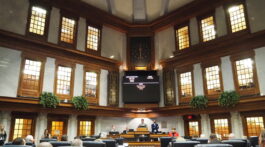Indianapolis Mayor Joe Hogsett will present his 2026 city budget Monday night — a $1.7 billion spending plan that sources say is balanced, requires no tax increases, and protects existing union contracts.
According to those familiar with the proposal, the budget reflects fiscal discipline in the face of a $43 million shortfall discovered during the planning process. That gap was closed without raising taxes by holding most city agencies to spending levels roughly four percent below their initial requests. The result, sources say, is a leaner budget that focuses on maintaining core services rather than expanding programs.
For the first time in city history, sources say, income tax revenues will outpace property tax collections — a shift driven less by booming wages than by the long-term squeeze on property tax revenue. State-imposed property tax caps, slow growth in assessed values, and other structural limits have kept property tax collections in check for years. That dynamic, sources note, means Indianapolis is increasingly reliant on local income tax receipts to fund day-to-day operations.
Public safety will receive the bulk of any new spending. Sources say the Indianapolis Metropolitan Police Department, Indianapolis Fire Department, and Marion County Sheriff’s Office will see funding increases, while nearly all other departments will remain at essentially flat levels, with only minimal adjustments for contractual obligations or inflation.
Reserves — the city’s financial safety net — will remain fully funded under the plan, which sources describe as a key measure of fiscal health. That stability, they say, comes despite inflationary pressures, rising personnel costs, and ongoing demands on public safety resources.
Still, holding most agencies to flat budgets may spark debate at the City-County Council. Critics could question whether holding back four percent in agency spending will slow service delivery or delay planned projects in areas like public works, parks, and neighborhood development.
The mayor’s budget address will mark the beginning of several weeks of public hearings and council committee reviews, with a final vote expected later this fall. Between now and then, the administration will make its case that the proposal balances restraint with investment.
“This is a budget that lives within its means,” one source said. “It keeps promises to workers, funds public safety, and protects taxpayers — without asking them for a penny more.”











